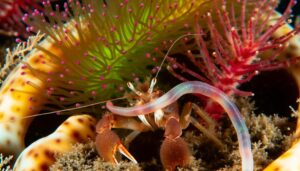How Do Hermit Crabs Trade Shells?
Yes, hermit crabs do "talk" to each other, but not like humans. They use tactile signals, chemical cues, visual displays, and sound vibrations.
You'll often see them touch antennae and legs to sense their surroundings or release pheromones to find mates and establish dominance. Visual displays indicate aggression or submission, while sounds and vibrations help convey threats or mating opportunities.shell exchanges, they might use stridulation sounds to communicate needs or availability.
If you look into their complex behaviors, you'll gain deeper insights into their fascinating social interactions.

Key Takeaways
- Hermit crabs communicate through tactile signals, chemical cues, and visual displays.
- They use antennae and legs for touching and sensing their environment.
- Chemical signals like pheromones help identify mates and establish social hierarchy.
- Stridulation sounds from rubbing legs against shells convey various messages.
- Vibrations are used to establish territory boundaries and minimize confrontations.
Understanding Hermit Crab Behavior
Hermit crabs exhibit a variety of complex behaviors that are essential for their survival, including shell selection, social interaction, and foraging habits.
You'll find that their shell selection is a meticulous process, as they assess potential shells for size, weight, and condition. Studies show that hermit crabs often engage in shell exchanges, with data indicating that up to 30% of individuals might participate in these exchanges during peak periods.
Social interaction is also critical; they form temporary clusters, which can enhance their foraging efficiency. Observational data suggest that clustering increases the likelihood of finding food by 50%.
Understanding these behaviors allows you to better care for hermit crabs, ensuring their well-being and promoting a thriving environment.
Methods of Communication
Investigate the nuances of how hermit crabs communicate through tactile signals, chemical cues, and visual displays to understand their social dynamics. Hermit crabs often use their antennae and legs to touch and sense their environment, conveying information about food sources or potential threats.
Chemical cues, such as pheromones, play a significant role in identifying mates and establishing hierarchy within groups. Visual displays, including body postures and claw movements, are critical during interactions, indicating aggression or submission.
The Role of Shell Exchanges
Frequently observed in both wild and captive environments, shell exchanges among hermit crabs play an essential role in their survival and social hierarchy. You'll notice that a suitable shell provides protection and mobility, directly influencing a hermit crab's longevity.
Studies reveal that crabs often engage in organized 'vacancy chains,' where multiple individuals exchange shells in a sequence. This behavior minimizes injury and maximizes efficiency. Data indicate that larger and more dominant crabs typically initiate these chains.
Sound and Vibrations
Sound and vibrations serve as critical communication tools among hermit crabs, enabling them to convey information about threats, mating opportunities, and territory disputes. By generating stridulation sounds through rubbing their legs against their shells, hermit crabs can produce distinct acoustic signals.
Studies have shown that these sounds vary in frequency and intensity, depending on the message being conveyed. For example, a rapid series of vibrations might indicate an imminent threat, prompting other crabs to seek shelter. Additionally, during mating rituals, males emit specific frequencies to attract females.
Observations indicate that hermit crabs also use substrate-borne vibrations to establish territory boundaries, effectively minimizing physical confrontations. By understanding these communication methods, you can better appreciate the intricate social behaviors of hermit crabs.
Chemical Signals
Hermit crabs use chemical signals to communicate essential information about their environment, social status, and reproductive readiness. You'll find that these signals are vital for their survival and social interactions. Hermit crabs release pheromones, which other crabs detect through specialized sensory receptors. This chemical communication can indicate the presence of food, potential mates, or threats in the vicinity. Analyzing their chemical signaling offers insight into their complex behaviors and social structures.
| Chemical Signal | Purpose | Detection Method |
|---|---|---|
| Pheromones | Reproductive readiness | Sensory receptors |
| Alarm signals | Presence of predators | Sensory receptors |
| Aggregation cues | Food location | Sensory receptors |
Understanding these signals can guide you in creating an ideal habitat or conducting further research on hermit crab social dynamics.
Conclusion
To sum up, hermit crabs communicate through various sophisticated methods, including sound, vibrations, and chemical signals.
These mechanisms are essential for their social interactions, such as shell exchanges.
For example, in a controlled study, researchers observed that hermit crabs use specific vibrations to signal readiness for a shell trade, ensuring mutual benefit.
Understanding these behaviors provides deeper insight into their complex social structures, highlighting the significance of communication in their survival and adaptation.






